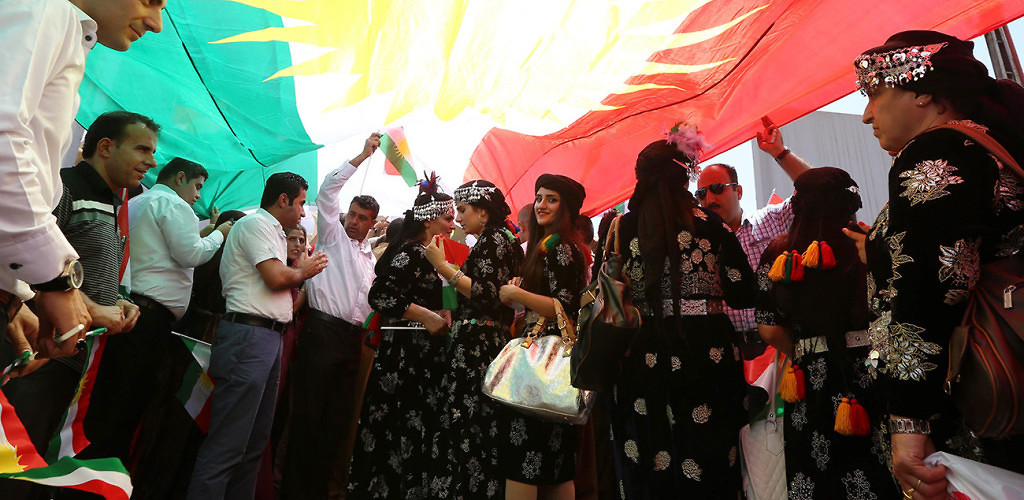Iraqi Kurds call for full independence outside the Kurdistan parliament building. Erbil, Iraq, July 3, 2014. (Safin Hamed/Getty Images)
The Kurds are no stranger to secessionism, having attempted to carve independent states out of Turkey, Iran, and Iraq over the past 100 years. At the moment Iraqi Kurdistan exists as an effectively de facto state within a severely fractured and war-torn Iraq. The recent rise of the so-called Islamic State in the region has also helped reinvigorate the idea of Kurdish independence, by drawing international attention to the peril of state failure. The situation prompted Masoud Barzani, the president of Iraq’s Kurdish regional government, to say to the Kurdish Parliament last July: “The time has come to decide our fate, and we should not wait for other people to decide it for us.”
But the fate of the Kurds is not entirely in their own hands, for true sovereign independence requires the recognition of other states. Typically, though, governments are reluctant to grant this recognition, since it might violate the sovereignty of the larger state from which the breakaway region aims to secede. In this case, the sovereignty of Iraq is an obstacle to the secession of Kurdistan. Given this, a clear long-term strategy for the Kurds is to gain as much autonomy as possible and develop a unique administrative status within Iraq. This matters in the eyes of both the government in Baghdad and the international community.
At the outset of the American Civil War, President Lincoln famously argued that the Confederate declaration of independence forced the rest of the country to choose between dissolution and blood. But as I discuss in a recent article in International Organization, administrative organization provides governments with a third option. Using a large amount of original data, I show that central governments use administrative lines and categories when determining which groups can secede without fear of setting a precedent, and who they must deny and potentially fight in order to maintain a credible reputation. The more administratively unique the breakaway region, the more likely they are to be recognized.
Administrative lines and categories shape secessionist outcomes in three mutually reinforcing ways. First, laying claim to a specific territory with an identified boundary helps the relevant parties to overcome the basic problem of where to place borders. This is important given that nations are typically fuzzy, overlapping groups rather than discrete, easily delineated units. The Kurdish regional boundaries are mostly defined, with the great exception of the uncertainty surrounding the ownership of Kirkuk. The Kurds would therefore do well to sort this issue out soon.
Second, administrative organization creates status categories that over time can become salient in the minds of the relevant parties. For an extreme example of this effect, consider that the islands of Hawaii and Puerto Rico were acquired by the United States in 1898 and then placed into different administrative categories for local political reasons that had significant downstream consequences. Puerto Rico was admitted as an unincorporated territory, a category that constitutes the outer belt of the various American units. Like other units in that category, Puerto Rico has the right to secede. Hawaii, on the other hand, was inducted as an incorporated territory. As a type of unit that is subject to the full weight of the constitution, Hawaii’s chances for eventual secession were dramatically reduced over 100 years ago when the relevant actors decided to incorporate it. Whereas its secession would set a precedent for the other 49 states, the secession of Puerto Rico would not.
Third, both of the above points are reinforced by international law, which, since at least the dissolution of the Spanish Empire in the Americas, has emphasized internal administrative territories as a guide for recognizing new states. Based on the principle of uti possidetis, international law holds that emerging states should inherit their administrative boundaries at the time of independence. Regarded by international lawyers as a least-bad solution, uti possidetis was applied to decolonization, which relied on an administrative snapshot of the European empires, and during the Soviet and Yugoslav dissolutions, which permitted independence to constituent republics and denied it to all other claimants.
The administrative architecture of states actually structures how they respond to secessionist demands. These architectures may have been created for other reasons. They may be arbitrary, poorly drawn, or the product of geopolitical calculations, but they nevertheless present a blueprint for how states can downsize territory, and they continue to feature in both the legal arguments of aspiring nations and in the responses of states and international organizations who decide their fate.
There are two ways the Kurds can get full independence: by getting the consent of the Iraqi government, or winning the support of key powerful states that are willing to circumvent the wishes of Baghdad. The likelihood of either path increases in proportion to the perception that Iraqi Kurdistan is administratively unique; a special region whose secession will not set a precedent for other ethnic groups in Iraq or the Kurdish minorities in neighboring countries.
Taking the long view, the Kurdish leadership has an interest in defining its administrative boundaries and seeking to gather as much autonomy as possible. There is already a history of autonomy—indeed the current constitution of Iraq could be interpreted as a voluntary union—but increased administrative distinctiveness will allay concerns over precedent-setting and fragmentation and potentially open the door to independence.
Ryan Griffiths is a lecturer in the Department of Government and International Relations at the University of Sydney.





